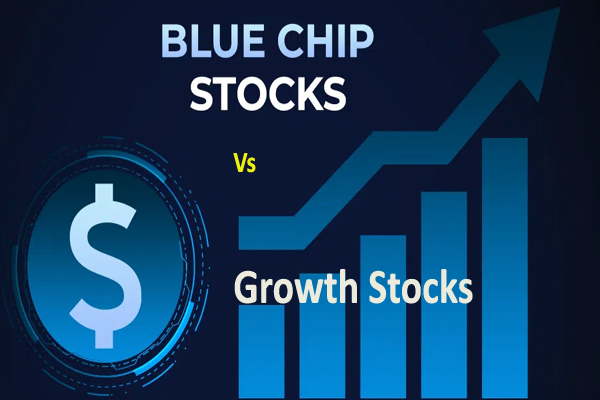
In the dynamic landscape of stock market investments, understanding the nuances between Blue-Chip and Growth stocks is pivotal for crafting a well-rounded investment strategy. Each type offers distinct characteristics that cater to different investor preferences and financial objectives. This article delves into the fundamental differences between Blue-Chip and Growth stocks, explores their unique traits, and provides strategic insights on achieving a balanced investment portfolio.
Understanding Blue-Chip Stocks
Blue-chip stocks are renowned for their long standing reputation, stability, and reliability. These companies are industry leaders with established track records of financial performance and operational consistency. Examples include household names like Coca-Cola, Microsoft, and Johnson & Johnson. Investors are drawn to Blue-Chip stocks for their consistent dividends, lower volatility relative to Growth stocks, and perceived lower risk.
One of the primary attractions of Blue-Chip stocks is their stability. These have demonstrated resilience over time, navigating economic downturns and market fluctuations more effectively than smaller or newer firms. Moreover, many Blue-Chip companies distribute regular dividends to their shareholders, appealing to income-oriented investors. However, it’s essential to recognize that while Blue-Chip stocks are generally considered safer investments, they are not entirely immune to risks such as industry disruptions or shifts in consumer preferences. Click to learn more about blue-chip stocks.
Exploring Growth Stocks
Growth stocks represent companies with substantial potential for rapid expansion and capital appreciation. These firms often reinvest their earnings into further growth opportunities rather than distributing dividends. Examples of well-known Growth stocks include Tesla, Amazon, and Netflix. Investors are attracted to Growth stocks for their potential to deliver significant returns over time, driven by innovations, market disruption, or expanding market opportunities.
The allure of Growth stocks lies in their potential for high returns. Investors willing to tolerate higher volatility and greater risk may benefit from the substantial growth trajectories these companies can experience. However, it’s crucial to acknowledge that the same growth potential also introduces higher levels of uncertainty and market fluctuations. Growth stocks can be more susceptible to economic downturns or shifts in investor sentiment, making them potentially riskier investments compared to Blue-Chip stocks.
Key Differences Between Blue-Chip and Growth Stocks
The fundamental distinction between Blue-Chip and Growth stocks lies in their risk profiles and potential rewards. Blue-chip stocks offer stability, steady dividends, and lower volatility, appealing to conservative investors seeking reliable income streams and capital preservation. In contrast, Growth stocks offer higher potential returns but come with increased volatility and the potential for greater losses during market downturns.
Another distinguishing factor is the size and market capitalization of the companies. Blue-chip stocks are typically large-cap companies with well-established market positions and extensive operational histories. In contrast, Growth stocks may encompass smaller or mid-cap companies that are in the early stages of growth and expansion.
Blue-chip stocks tend to perform more resiliently during economic downturns or periods of market uncertainty due to their established market positions and diversified revenue streams. Growth stocks, while potentially offering higher returns during bullish market conditions, may experience sharper declines during market corrections or economic recessions.
Factors to Consider When Choosing Between Blue-Chip and Growth Stocks
The decision to invest in Blue-Chip or Growth stocks should align closely with investor goals and risk tolerance. Conservative investors focused on wealth preservation and steady income may lean towards Blue-Chip stocks. In contrast, investors with a higher risk tolerance and a longer investment horizon may find Growth stocks more appealing, seeking capital appreciation over time.
Investment time horizon plays a critical role in determining the suitability of Blue-Chip versus Growth stocks. Blue-chip stocks are often favoured by investors with shorter time horizons or those nearing retirement who prioritise stability and income generation. In contrast, Growth stocks are typically suited for investors with longer time horizons who can withstand short-term volatility in pursuit of higher long-term returns.
Consideration of prevailing market conditions and economic outlook is essential when selecting between Blue-Chip and Growth stocks. Economic cycles and sector-specific trends can influence the performance of these stocks differently. Blue-chip stocks may provide defensive qualities during economic downturns, whereas Growth stocks may thrive in expanding economic environments.
Strategies for Balancing Blue-Chip and Growth Investments
Achieving a balanced investment portfolio involves diversifying across asset classes, sectors, and types of stocks. Incorporating both Blue-Chip and Growth stocks can help mitigate risk while capturing opportunities for growth and income generation. Diversification spreads investment risk and enhances the overall stability of the portfolio.
Strategic allocation across different sectors can further enhance portfolio diversification. Blue-chip stocks often span diverse sectors such as healthcare, consumer goods, and technology, offering exposure to varied market segments. Meanwhile, Growth stocks may be concentrated in high-growth industries such as technology, biotechnology, or renewable energy.
Conclusion
The choice between Blue-Chip and Growth stocks depends on investor preferences, financial goals, and risk tolerance. Each type of stock offers unique advantages and considerations, from stability and dividends in Blue-Chip stocks to growth potential and volatility in Growth stocks. By understanding these differences and implementing a balanced approach through diversification, sector allocation, and regular rebalancing, investors can navigate the complexities of the stock market and strive to achieve their investment objectives effectively.
Follow – https://techshar.com for more Updates


